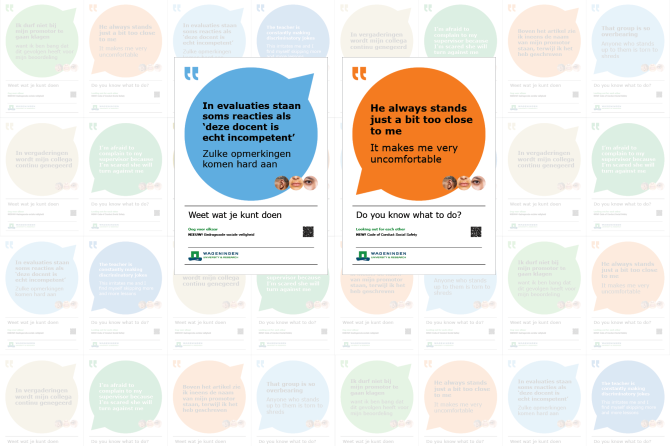Wageningen University & Research presents a new code of conduct to help students and employees deal with undesired behaviour. In the new 'Social Safety Code of Conduct', it is the experience rather than the intention that is leading. Moreover, new guidelines for relationships on the work floor have been released.
The Social Safety Code of Conduct details what is considered undesired behaviour, what guidelines apply and what to expect from your supervisor and colleagues when you address undesired behaviour. The new code of conduct is based in part on dialogues with students and employees during workshops. A joint definition of undesired behaviour was formulated as follows: 'Behaviour that is experienced as undesired or offensive and aims to make or results in making a person feel unsafe at their place of work or study.' WUR has launched a poster campaign with small and big examples of undesired behaviour.
The two new codes describe new standards for undesired behaviour and private relationships at work but also offer tools for employees and students. 'We already had a code of conduct, but its focus was on ideal behaviour', says Joyce van der Velde, programme manager for Looking Out for Each Other. 'What was lacking was a boundary-defining guideline. What constitutes undesired behaviour? What is considered a relationship at work? Where can you go, what may you expect, and what is expected of you?'
Every report merits a follow-up
'How something is intended is not the determining factor in undesired behaviour. Rather, the focus is on how behaviour is received.' Still, the code describes examples of such behaviour: discrimination, intimidation, bullying, and violence. 'All major examples,' says Van der Velde. 'But the category aggression includes such behaviour as name-calling and obstructing. Obstructing someone may seem like you're not actually doing something, but it can still come across as aggressive', she explains. 'And, ultimately, it is all about how the behaviour is experienced.'

The new code of conduct also stipulates that reports of undesired behaviour may never be ignored but must always be taken seriously. Each report merits a follow-up. This follow-up is the responsibility of employees with an added responsibility for social safety, such as teachers, HR consultants and supervisors. 'More is expected from them. It is there that undesired behaviour is reported; they are role models, and they must intervene where needed.' Those involved are expected to address problematic behaviour and accept being called out on their behaviour. 'A report must suffice to address problematic behaviour.'
What is WUR's approach to relationships at work?
The Relationships at Work code focuses on relationships between WUR employees and between students and teachers. These relationships include romantic relations but also kinship of the first degree, such as parents, children, and siblings. In such cases, there is an overlap between personal and professional relationships. 'Most relationships do not cause unsafe situations. Some do, however. For those involved or for their colleagues. Consider, for example, the effect of a break-up on the atmosphere at the office.'
'Relationships are not forbidden. After all, many people meet their partner at work. The code explains what to do when you enter into a relationship. Hence, it describes that private relationships must be reported, by whom, and what measures are to be taken. 'This is largely determined on the balance of power', Van der Velde clarifies. 'If a teacher and a student become involved, for example, the supervisor ensures that the teacher no longer has to grade the student's work.'






